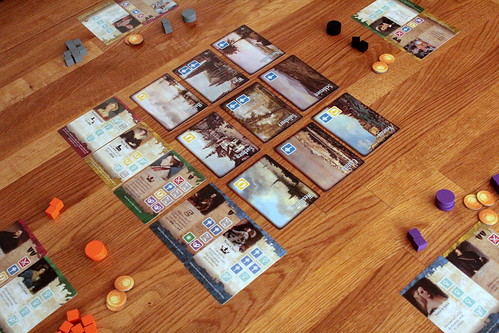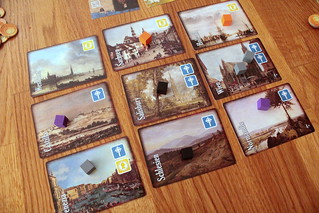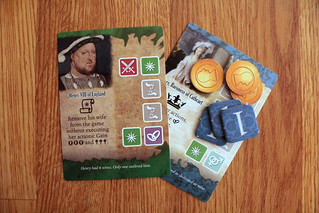| Strategy | Luck |
|---|---|
| Interaction | Components & Design |
| Complexity | Score |
So the game is about historic personalities, personalities represented by cards.Each of the three to five players starts with two cards in play, one man, one woman, his ancestral couple. They are where your dynasty start, and they are married right from the start, so you can only activate the two of them together. Each card has a couple of important features, the relevant one for activating a card being the four rows of action icons. When it’s your turn you activate one of your cards – or a married couple – pick one row of actions and take those actions from left to right. In the first round you only have one couple in play, so the choice who to activate is easy. What to do, on the other hand, is tricky straight from the start because of the combination of actions you choose from.

Some actions are incredibly simple. When you take a Piety action during your activation you take a Prestige Point and you’re done. The same goes for a Commerce action, you simply take one gold coin. But what you really want to do on the first round is start your dynasty and give birth to a child. Actually, you can’t really avoid it, all action rows on your ancestral couple include a Birth action. Now, having children in Among Nobles is not the messy, random thing of the real world, where your family needed an able strategist and had a genius tuba player instead. When you give birth, you pick your child from the row of children available for this round, seven when the round starts but not immediately refilled after one is taken, so just before the round is over you may still get stuck with the tuba players.
But you don’t just pick any child from that row, there are two things to take into account. First, the child must share a Trait, represented by the card’s background color, with one of the parents. Second, the child must be of the right gender. A Birth action dictates the gender of the child you can have, and this being the olden days having a daughter is less valuable for your dynasty, only sons can carry on the family name. But daughters are easier to have – the action is more common – and they are free while giving birth to a son costs a gold coin. Beyond those restrictions there are, of course, strategic considerations in picking an offspring. Does the card have actions that you need, and does it maybe come with gifts when it is born. Some cards have a Birth Bonus, usually in the form of points or coins, sons may also add armies to your supply. The child thus acquired goes in your card display in the row below his or her parents.

But having children is not all you need to continue your dynasty, you also need to marry them off. Unlike the messy reality of European nobility, that always means with a member of another family, and it is where the difference between sons and daughters is especially important. With a Marriage action you can only find a match for a son. You pick a son you wish to be married and pay two coins, then all other players who have unmarried daughters must present one of them. You pick one of them and get the two of them hitched. The bride’s family loses a daughter – which can be painful if her actions are good – but is rewarded with two Prestige Points and the bride’s Alliance Bonus if she has one. You push the bride’s card under your son’s so that only her action symbols are visible. Any personality she may have had in the form of special abilities disappear that way, but she will dutifully support her husband from that point on: when you want to activate the husband you activate the couple instead and take all the actions in one row on both cards.
That is, of course, an important factor in your decision which daughter to pick, the actions should be useful to you and ideally she should have strong actions in the same row that her husband has strong actions as well. One problem with that: cards with strong actions in the same row often have the same Trait, and that means the newlyweds can only have children of that one Trait instead of being able to chose between two. In some rounds, that may mean there are no children for them to have.
An especially important action symbol when playing matchmaker is the Intrigue action. This action does something different for each card, described in the card’s text. For women that means her Intrigue action is lost in marriage, the text is on the part of the card her husband covers. But she still does have the Intrigue symbols, and if the husband’s card has an Intrigue action she will activate that. You get some husbands with very powerful Intrigue actions but few or even no Intrigue symbols, and you get brides with no Intrigue actions of their own but a liberal sprinkling of Intrigue symbols. Some of these couples with a penchant for Intrigue can be a royal pain in the ass for your opponents. Historical accuracy aside, you can get the Duke of Wellington married to Mary, Queen of Scots. She has a ton of Intrigue symbols, he has an Intrigue action that sends opponents’ armies back to their owners’ supply. And they both have a bunch of Warfare symbols as well to make use of the space they just created.

Warfare is the last action you find on the cards, and it has to do with the nine province cards. When taking a Warfare action you can either pay a coin and move an army from your supply to a province card, or you can move an army from one province to another for free. The provinces generate income for their controller at the end of each round. If more than one player has armies in a province, then you remove cubes from all players, one by one, until only one player is left, that player takes the income: coins, points or both.
With all the actions in place, the flow of the game is now quickly explained. Each round play goes around the table three times, whenever it’s their turn a player may activate one character or couple and take their actions. At the end of the round the provinces generate income and the supply of children is replenished. That last part is another big deal in Among Nobles, because children come in three generations, three piles of cards. Whenever one of them runs out it triggers a generational change at the end of the next round, meaning the oldest generation in each player’s family dies. That is a bad thing not only because it’s death but also because you lose the actions from those characters. On the plus side, their death makes space for a new generation in your dynasty because you’re limited to three generations at any given time. Everyone is doomed never to see their great-grandchildren, which is extra sad. But some characters leave the game with a parting gift in the form of a Legacy, a bonus you gain when that character dies. After the third generational change has happened the game ends and the player with the most points wins.
Despite the relatively brief rules – the most difficult thing is remembering when you have to pay coins to take an action – Among Nobles is a game with a very satisfying strategic depth. Crafting your dynasty to win the game takes many decisions, and there are many ways to victory. Warfare is an obvious one, control as many provinces as you can and take their income. But don’t underestimate the simple strategy of having many Piety actions and activating them as often as you can, either. Or the simple money strategy. An exchange rate of three coins for one point at the end of the game is not great, but it can make you quite a few points. Especially if you manage to have Charles le Victorieux die in the last generational change, his Legacy doubles the money you have at the time. None of those strategies are simple do-this-and-win, either, you always have to be smart about having children and marrying them to the right people.

And even though there is a lot to think about and many decisions to be made, downtime in Among Nobles is minimal. Most turns take between 30 seconds and a minute, and the longest action, Marriage, even involves the other players. You always have something to do, and it’s always strategic and mostly interactive, it’s just great. And there’s an extra layer of fun to be had when playing with history buffs. I can’t say that Among Nobles is a historically accurate game, there are only three generations separating Charlemagne and Napoleon Bonaparte, but some cards are wonderfully fitting. Henry VIII of England actually has an Intrigue ability to kill his wife, for instance. Or there’s Anne Boleyn that made one of our testers cry out “Of course Anne Boleyn has so many Intrigue symbols”. Some thought definitely went into those cards.
Building your dynasty of historic personalities sounds dry, I’ll be first to admit that, but between simple rules, many strategic decisions and a level of interaction that keeps everyone involved but doesn’t bog down the game in long negotiations, I count Among Nobles as one of the Kickstarter success stories.








